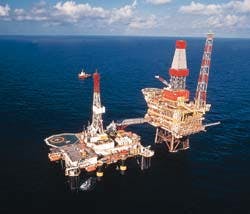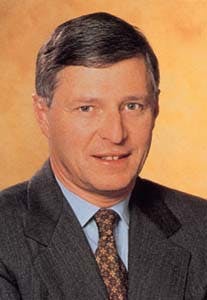Thierry Desmarest
Chairman and CEO
Total
Total developed Dunbar field with a minimally manned platform, tender-assisted drilling, and multiphase export of oil and gas in a double-wall, insulated pipeline. Shown here are the tender and production platforms. Photo courtesy of Total.
- Total Oil Marine's North Sea Interests [96,652 bytes]
- Total's North Sea Production [173,111 bytes]
- Total's Norwegian Fields, Pipelines [73,291 bytes]
- Remaining Norwegian Reserves [127,210 bytes]
"After increasing two-fold over the last 10 years, driven by revolutionary technology and new discoveries, our North Sea production should remain relatively constant over the next decade and should account for some 20% of the total oil and gas we produce worldwide and one quarter of our upstream operating profits," Total Chairman and CEO Thierry Desmarest said at the 10th anniversary celebration of the Alwyn field start-up in the U.K. North Sea. Total is operator of Alwyn, in association with Elf Aquitaine.
Total's North Sea output
Through its subsidiary Total Oil Marine plc, Total has production of 88,000 boed in the U.K. North Sea. It is operator of the Alwyn fields and the Frigg transport system. It also participates in Bruce, Caister, Mallard, Markham, and Murdoch fields, as well as in the high-pressure/high-temperature Mungo and Monan fields in the Eastern Trough Area Projects (see map, p. 24).In Norway, Total Norge AS produces 70,000 boed. It participates in 33 fields, including Ekofisk, Troll, Oseberg, Sleipner East, Veslefrikk, the Frigg area, and Heimdal. It is an active partner in Åsgard, due on stream in the Haltenbanken in 1999, and it is in line for the longer-term development of Haltenbanken South, Huldra, and Sn hvit fields.
Total also holds stakes in the area's terminals and pipeline infrastructure (Karstoe, Europipe, Norfra, etc.).
Total Oil & Gas Nederland BV (TOGN) has interests in a number of Dutch fields, including offshore Block K6/L4/L7, which, along with K4a, is in a developing area. It is also a participant in Markham and Zuidwal fields offshore and Leuwarden field onshore.
Total's production in the Netherlands is 22,000 boed.
TOGN is also associated with the gas transport network there.
In Total's overall scheme of things, the North Sea, with its politically stable environment, is a strongly profitable area and is expected to remain so in the years to come. Last year, it generated revenues of about 6.6 billion francs, profits of 2.3 billion francs, and cash flow of 3.57 billion francs for Total, while accounting for one quarter of the company's overall production of 790,000 boed.
Total's North Sea production consists of about half oil and half gas. After doubling in the last 10 years, the firm's output in the area has fallen slightly the past 2 years because of declining Frigg oil production. The slack will be taken up, however, when Åsgard comes on stream in 2 years.
Desmarest reckons Total's overall North Sea production will hold steady at about 180,000 boed, and possibly even rise to 200,000 boed in 7-8 years, with gas taking on growing importance. There could be a slight decline of production in the Netherlands after 2000, but overall production should not fall below 170,000 boed, he says.
Reserves
Desmarest is equally sanguine about the group's North Sea reserves, which he described as "relatively comfortable."Proven North Sea reserves account for 12% of Total's world reserves total of 4.638 billion boe. They have increased from 476 million boe in 1996 to an estimated 555 million boe today.
Total expects its North Sea reserves to increase further by 2005 through a program of exploration, development, and acquisitions. Indeed, the company will maintain its capital investment in the area for the next few years at the 1996 level of 12 billion francs. This is one third of the group's overall upstream spending.
This fraction is expected to fall to 20% by about 2005, however, but only because of the growing share of Total's outlays in other regions.
Total in Norway
In Norway, Total ranks fifth in gas reserves, with 103 billion cu m (see chart, p. 27). It ranks sixth in combined oil and gas reserves, with 977 million boe.More specifically, it is the only company whose discoveries, expressed in ultimate recoverable volumes of oil and gas, exceed that of oil and gas already being produced or developed.
In the North Sea, the stakes are high, and licensing rounds fetch exorbitant prices. But Desmarest believes in keeping to a careful strategy.
"We have significant reserves worldwide," he said, "and are not prepared to acquire further ones at any cost. Our strategy is to focus around our strong points, divest marginal positions through swaps or sales, and seize opportunities as they arise."
Typical was the 7.65% Total acquired in Norway's Haltenbanken in the late 1980s, when reserves there could be had cheaply, "because nobody believed in the area at the time," said Desmarest. Transport costs fell sharply, and technological breakthroughs greatly improved the economics for developing the fields. This made development of ?sgard field possible.
Total is strongly involved in all stages of this development. Deputy general manager of Total Norge, Daniel Picard, chairs the project's management committee.
Total also seized an exceptional opportunity to acquire at a reasonable cost Australia's BHP Petroleum Pty. Ltd.'s share in the Eastern Trough Area Project, which has estimated reserves of 200 million boe. In that project, Total now has a 12.42% in the U.K. North Sea's Mungo and Monan fields, in association with Saga Petroleum AS.
Technical challenges
While reserves in Norway are being boosted by new discoveries, in the U.K. North Sea, it is technology that is the driving force in maintaining and increasing production (see related story, p. 22).The Atlantic margin offers some promise of new discoveries, but Desmarest estimates the chances of success there at only 10%.
Total is involved in a number of major technical projects in the North Sea. Desmarest described the area as a "tremendous laboratory" of new technology in which all companies can participate, whether as operator or partner.
"The limits to technology are as high as the vision one has of them," he said.
Alwyn is a case in point. Ten years ago, when this very complex field came on stream, recoverable reserves were estimated at 400 million boe. Three years ago, with the development of satellite fields Dunbar, Ellon, and Grant, reserves estimates were boosted to 700 million boe. The discovery of reservoirs in horizons deeper than those already in operation-in the Triassic at about 5,000 m-now has pushed reserves up to 1 billion boe.
Production there began in August 1996 with output of 1.2 million cu m/day of gas and 4,000 b/d of condensate. A second well was successfully tested in April 1997 and confirmed the new reservoir's potential.
Farther south, on a separate structure, a wildcat in the Triassic flowed 0.5 million cu m/day of gas and 1,000 b/d of condensate on test in April 1997. The well may be developed from subsea installations linked to the Alwyn platform.
The extension of Alwyn North through satellites and deeper wells was done for less than £1.5/bbl. This was made possible through maximum use of existing infrastructure at Alwyn North and subsea installations.
Dunbar, considered to be at the upper limit of marginal fields, is 22 km from the Alwyn North platform. It was developed using a minimally manned platform, tender-assisted drilling, and multiphase export of oil and gas in an innovative double-wall, insulated pipeline (see photo, p. 21).
Ellon and Grant development were developed as subsea satellites of Dunbar platform, which in turn was tied back to Alwyn North.
Current total output of the Alwyn complex is 85,000 b/d of oil and condensate and 11 million cu m/day of gas. Further hydrocarbons will be produced when a project is launched in 1999 to inject miscible gas into the initial Alwyn North reservoir to "wash out" the oil remaining in the structure. Charles Mattenet, manager of Total North Sea E&P, called it "the first ever such venture in the North Sea."
"We hope to recover (a further) 16% of crude from the reservoir-a (total) rate of nearly 75%," said Mattenet. "We have become prudent about considering an area mature," he added. "Oil production in overall U.K. North Sea will reach 2.7 million b/d this year. This is three times what Total had forecast in 1987."
Logistics, infrastructure
Two years ago, Total reworked all its forecasts based on the assumption that what could be recovered from existing fields had been rather underestimated. Also, little account had been taken of new fields that had become "developable" because of technological advances."The floating production and subsea wellhead development of ?sgard would have been unthinkable 4 years ago," said Mattenet. Given these new premises, he says, Total has a much more optimistic view of North Sea reserves than do traditional evaluation bodies.
Together with technological advances, Total relies on its existing infrastructure and logistics for economically extending its North Sea production. The decision to develop the Alwyn area, for example, was taken because of nearby transport systems.
This includes the Ninian Central pipeline north of the field to the Sullom Voe terminal for oil lifting and the Frigg gas lines to the south, leading to the terminal at St. Fergus, Scotland-operated by Total-where 15% of U.K gas arrives.
In the Dutch North Sea, Total also carries out developments in line with logistics and infrastructure.
And logistics underpin Total's consideration of projects involving a number of Eocene gas fields between Alwyn and Frigg. These fields could be developed economically on a subsea basis, linked to the Frigg or North Alwyn installations.
Likewise, logistics are central to a project to connect the U.K. Frigg line to new Norwegian developments through Frigg field facilities. An agreement was signed between the two countries' governments a few months ago, giving Norway the right to export gas to the U.K. when Frigg has depleted and the line is idled in 2000-02.
Norway will have the option to link its gas lines to the Frigg pipeline, from either Heimdal or Oseberg, to feed the U.K. market. The Huldra development, near Heimdal, could be the first to put the planned Frigg connection to use.
As Total sees it, this connection would spark off further cooperation between the U.K. and Norway as reserves are pooled and the best use is made of platforms and pipelines for profitable projects.
As operator of the Frigg transport system and a participant in a number of planned North Sea production projects, Total is on both sides of the fence. The firm will try to act as a catalyst in securing business for the new system, which would sustain the Frigg gas line for the next 20 years.
"If the Frigg line is filled," a Total executive told OGJ, "it will account for 10% of the U.K. market."
He added that it was not unreasonable to think that the line might some day work both ways, bringing gas from the U.K. fields to the continent.
Thierry Desmarest "Our strategy is to focus around our strong points, divest marginal positions through swaps or sales, and seize opportunities as they arise."
Copyright 1997 Oil & Gas Journal. All Rights Reserved.




